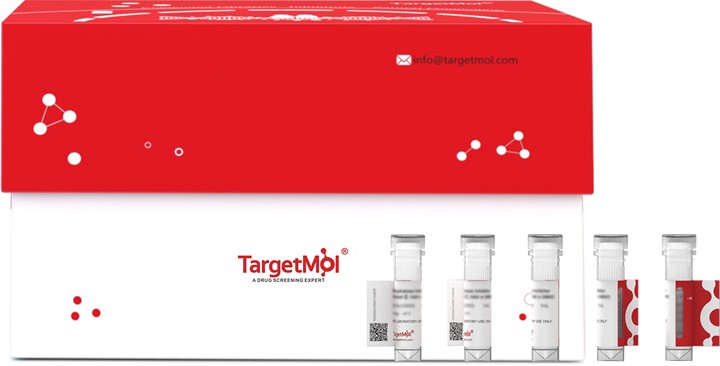 Your shopping cart is currently empty
Your shopping cart is currently empty
CD3 epsilon/CD3e Protein, Cynomolgus, Recombinant (aa 22-117, hFc)
T-cell surface glycoprotein CD3 epsilon chain, also known as CD3E, is a single-pass type I membrane protein. CD3E contains 1 Ig-like (immunoglobulin-like) domain and 1 ITAM domain. CD3E, together with CD3-gamma, CD3-delta and CD3-zeta, and the T-cell receptor alpha/beta and gamma/delta heterodimers, forms the T cell receptor-CD3 complex. The CD3 epsilon subunit of the T cell receptor (TCR) complex contains two defined signaling domains, a proline-rich sequence and an immune tyrosine activation motifs (ITAMs), and this complex undergoes a conformational change upon ligand binding that is thought to be important for the activation of T cells. T cell receptor-CD3 complex plays an important role in coupling antigen recognition to several intracellular signal-transduction pathways. This complex is critical for T-cell development and function, and represents one of the most complex transmembrane receptors. CD3E plays an essential role in T-cell development, and defects in CD3E gene cause severe immunodeficiency. Homozygous mutations in CD3D and CD3E genes lead to a complete block in T-cell development and thus to an early-onset severe combined immunodeficiency phenotype.

CD3 epsilon/CD3e Protein, Cynomolgus, Recombinant (aa 22-117, hFc)
| Pack Size | Price | USA Warehouse | Global Warehouse | Quantity |
|---|---|---|---|---|
| 5 μg | $80 | 7-10 days | 7-10 days | |
| 10 μg | $129 | 7-10 days | 7-10 days | |
| 20 μg | $198 | 7-10 days | 7-10 days | |
| 50 μg | $390 | 7-10 days | 7-10 days | |
| 100 μg | $626 | 7-10 days | 7-10 days | |
| 200 μg | $987 | 7-10 days | 7-10 days | |
| 500 μg | $1,900 | 7-10 days | 7-10 days | |
| 1 mg | $2,730 | 7-10 days | 7-10 days |
Product Information
| Biological Activity | Activity has not been tested. It is theoretically active, but we cannot guarantee it. If you require protein activity, we recommend choosing the eukaryotic expression version first. |
| Description | T-cell surface glycoprotein CD3 epsilon chain, also known as CD3E, is a single-pass type I membrane protein. CD3E contains 1 Ig-like (immunoglobulin-like) domain and 1 ITAM domain. CD3E, together with CD3-gamma, CD3-delta and CD3-zeta, and the T-cell receptor alpha/beta and gamma/delta heterodimers, forms the T cell receptor-CD3 complex. The CD3 epsilon subunit of the T cell receptor (TCR) complex contains two defined signaling domains, a proline-rich sequence and an immune tyrosine activation motifs (ITAMs), and this complex undergoes a conformational change upon ligand binding that is thought to be important for the activation of T cells. T cell receptor-CD3 complex plays an important role in coupling antigen recognition to several intracellular signal-transduction pathways. This complex is critical for T-cell development and function, and represents one of the most complex transmembrane receptors. CD3E plays an essential role in T-cell development, and defects in CD3E gene cause severe immunodeficiency. Homozygous mutations in CD3D and CD3E genes lead to a complete block in T-cell development and thus to an early-onset severe combined immunodeficiency phenotype. |
| Species | Cynomolgus |
| Expression System | HEK293 Cells |
| Tag | C-hFc |
| Accession Number | Q95LI5 |
| Synonyms | T-cell surface antigen T3/Leu-4 ε chain,T-cell surface antigen T3/Leu-4 epsilon chain,T-cell antigen receptor complex, ε subunit of T3,T-cell antigen receptor complex, epsilon subunit of T3,T3E,FLJ18683,CD3-ε,CD3-epsilon,CD3e molecule, ε (CD3-TCR complex),CD3e molecule, epsilon (CD3-TCR complex),CD3e antigen, ε polypeptide (TiT3 complex),CD3e antigen, epsilon polypeptide (TiT3 complex),CD3e antigen,CD3e,CD3 ε,CD3 epsilon |
| Amino Acid | Gln22-Asp117 |
| Construction | Gln22-Asp117 |
| Protein Purity | Greater than 95% as determined by reducing SDS-PAGE. (QC verified) |
| Molecular Weight | 38-55 KDa (reducing condition) |
| Endotoxin | < 0.1 ng/µg (1 EU/µg) as determined by LAL test. |
| Formulation | Lyophilized from a solution filtered through a 0.22 μm filter, containing 50 mM Tris-HCl, 100 mM Glycine, pH 7.5. |
| Reconstitution | Reconstitute the lyophilized protein in distilled water. The product concentration should not be less than 100 μg/ml. Before opening, centrifuge the tube to collect powder at the bottom. After adding the reconstitution buffer, avoid vortexing or pipetting for mixing. |
| Stability & Storage | Lyophilized powders can be stably stored for over 12 months, while liquid products can be stored for 6-12 months at -80°C. For reconstituted protein solutions, the solution can be stored at -20°C to -80°C for at least 3 months. Please avoid multiple freeze-thaw cycles and store products in aliquots. |
| Shipping | In general, Lyophilized powders are shipping with blue ice. Solutions are shipping with dry ice. |
| Research Background | T-cell surface glycoprotein CD3 epsilon chain, also known as CD3E, is a single-pass type I membrane protein. CD3E contains 1 Ig-like (immunoglobulin-like) domain and 1 ITAM domain. CD3E, together with CD3-gamma, CD3-delta and CD3-zeta, and the T-cell receptor alpha/beta and gamma/delta heterodimers, forms the T cell receptor-CD3 complex. The CD3 epsilon subunit of the T cell receptor (TCR) complex contains two defined signaling domains, a proline-rich sequence and an immune tyrosine activation motifs (ITAMs), and this complex undergoes a conformational change upon ligand binding that is thought to be important for the activation of T cells. T cell receptor-CD3 complex plays an important role in coupling antigen recognition to several intracellular signal-transduction pathways. This complex is critical for T-cell development and function, and represents one of the most complex transmembrane receptors. CD3E plays an essential role in T-cell development, and defects in CD3E gene cause severe immunodeficiency. Homozygous mutations in CD3D and CD3E genes lead to a complete block in T-cell development and thus to an early-onset severe combined immunodeficiency phenotype. |
Dose Conversion
Calculator
Tech Support
Keywords
| Size | Quantity | Unit Price | Amount | Operation |
|---|

Copyright © 2015-2025 TargetMol Chemicals Inc. All Rights Reserved.



